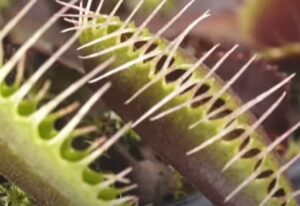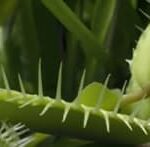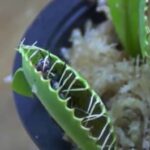As an Amazon Associate, this site earns commissions from qualifying purchases. For more details, click here.
Watching a Venus flytrap catch and eat insects never gets old, both for growers and researchers alike. When one of its traps is closed, you know the plant caught something. But how long do these traps stay shut?
Venus flytraps can remain closed for up to two weeks when feeding. How long it takes to digest a prey determines when the trap will reopen.
The trap only stays closed if it has caught something edible. If the object cannot be consumed, the trap will reopen in 1-2 hours. To understand how Venus flytraps can know the difference, we have to learn how, when and why its traps shut.
What Happens When a Venus Flytrap Closes?
Each trap on a Venus flytrap has trigger sensors which alert the plant when something falls into it. That is the first trigger or stimulus. Venus flytraps wait for several stimuli before it closes.
Venus flytraps count the stimulus and its actions determine what the trap does.
- First stimulus: a spider falls into the trap. The trap does not close.
- Second stimulus: if the spider moves around, it sets off the second trigger. The trap partially closes. The trigger must be set off within 30 seconds of the first one. Otherwise the trap will ignore it.
- Third stimulus: As the insect struggles to get out, it sets off another stimulus. The trap fully closes.
- Fourth stimulus: More movement sets off another trigger. The plant releases its digestive enzymes to consume the insect.
Sometimes Venus flytraps wait for 5 stimulus or triggers, but the basic process is the same. Once the trap is closed, it can remain shut for two weeks. Smaller prey takes about a week to consume, after which the trap reopens.
Because Venus flytraps can count and have short term memory, they can determine if the trapped object is edible or not.
As I mentioned, the trap will only close if there are two triggers. If debris falls and nothing disturbs it, the trap stays open.
If the debris ends in the trap and the wind tosses it about, the trap is going to close. But if nothing happens within 1-2 hours, the trap will open again.
Since debris are inanimate, it cannot produce the third trigger, which is needed to release its digestive juices.
Why is My Venus Flytrap Closed?
When a Venus flytrap grows traps will appear. They are going to be very small at first, but as the plant grows the traps can reach 1-2 inches in length.
When one or more traps are shut, it means the Venus flytrap is digesting food. Venus flytraps should eat every two weeks so at least one trap is always be closed.
Outdoor Venus flytraps have no problems luring bugs, but if it is indoors, I recommend feeding it. Hatortempt freeze dried mealworms are a good alternative to insects.
Usually Venus flytraps take 1-2 weeks to finish a meal. if the trap opens after just a few days, it probably caught a small prey.
If the trap opens up after a few hours, the plant caught something it could not eat like debris. The wind or rain will get rid of the debris or you can take it out.
Observe the trap if it stays shut even after two weeks. If the trap turns black, it’s going to die and fall off soon. This is normal as each trap has a limited lifespan. If your Venus flytrap is healthy it’s going to grow new traps.
Why is My Venus Flytrap Half Open?
This is one of the most common questions that new Venus flytrap growers ask. It might look alarming to see a trap that way, but there are many reasons why it can happen.
Safety mechanism. Venus flytrap traps depend on multiple triggers to conserve energy. If the trap is partially open (or half closed if you like), it means the plant is waiting for another trigger.
To recap: it takes three sensory triggers for a trap to fully close. And all of these must occur within 30 seconds of each other. So if you see the trap in this state, it is probably in standby mode and waiting.
Disabled. A trap that has been triggered too many times might get “disabled” or stop working. This may or may not be permanent.
This usually happens when people repeatedly touch Venus flytraps. Repeated stimulation exhausts the trap and it may lose its ability to close.
Caught a big prey. If a bug is too large for the trap, it won’t be able to fully close. If you see a half closed trap, look closely. You might see a bug too large for the trap stuck inside.
If its traps are triggered multiple times, it will close regardless of the insect size. If an insect is too large, the trap won’t be able to fully close.
Either one of two things will happen: one, the bug escapes and likely tear the trap apart.
Or the bug suffocates and dies in the trap. However, the trap will use all of its energy in an attempt to eat the entire bug. The trap will turn black, die and fall off.
A partially closed (or half open) trap is nothing to worry about. Venus flytraps grow several traps simultaneously, and if one falls off another will grow to take its place.

Why is My Venus Flytrap Not Closing?
This can be alarming especially if you just bought a Venus flytrap. . Let’s take a look at why this could be happening.
New environment. Like all plants, Venus flytraps need time to adjust to a new habitat. If you just purchased it, give the plant a couple of weeks to get accustomed.
The plant has spent its entire life in a store and suddenly finds itself in a new home. Venus flytraps get stressed when moved and often refuse to eat.
Just be patient. Provide plenty of light and water and its traps will open again.
Disease Venus flytraps can be infected by bacteria, gray mold or crown rot. Aphid infestation can prevent Venus flytraps from eating.
If a trap turns black, it probably caught a large bug and unable to eat it. Remove the half eaten bug immediately because it will rot. If the blackened trap falls off, that’s fine as another one will grow.
You can protect Venus flytraps from diseases by providing sufficient air flow. Keep the soil moist but don’t use too much water.
If you are not sure how much water, do this:
- Place your Venus flytrap in carnivorous plant soil and a pot with good drainage.
- Place the pot in a tray.
- Pour distilled water or rainwater in the tray until it is 1-2 inches deep.
The pot will absorb just the right amount of water for the plant.. Replenish the tray regularly.
Exhausted. If you purchased a grown Venus flytrap, don’t be surprised if some traps don’t close or die off. The traps may have been triggered on the trip or people may have played with it in the store. Just wait for new traps to appear.
Each trap can close from 5-15 times. After that, it will no longer catch bugs and focus on photosynthesis before dying.
Sometimes these traps turn black before it falls off the plant. That is nothing to be worried about. It’s a different story if multiple traps or the plant itself turns black however. That means it is sick.
Other Reasons
Temperature. Venus flytraps thrive in 70-95 F (21-35 C). If the temperature is too low its traps may refuse to eat. The same thing may happen if it is too hot.
Dormant. Dormant Venus flytraps will not eat. A lot of these plants shed their leaves in the fall and this may include the traps.
if your Venus flytrap starts to slow down in the fall, it’s normal. The plant is getting ready for its winter dormancy.
Dying. Each trap has a limited number of times it can catch prey. When it reaches that limit, it will no longer lure bugs.

My fascination with carnivorous plants began many, many years ago with Venus Fly Traps. Now I am more than happy to impart what I know with other enthusiasts and those who are curious about meat eating plants.


